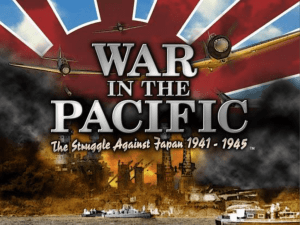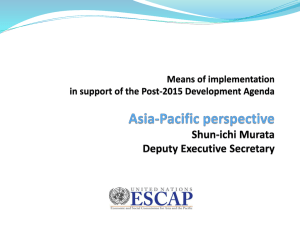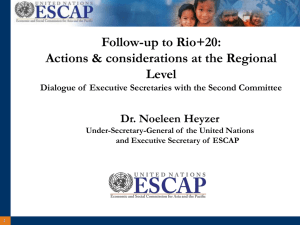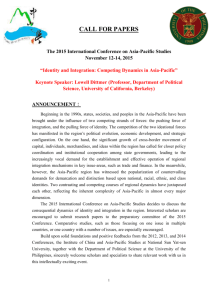서울대학교 외교학과 - Yonsei GSIS
advertisement
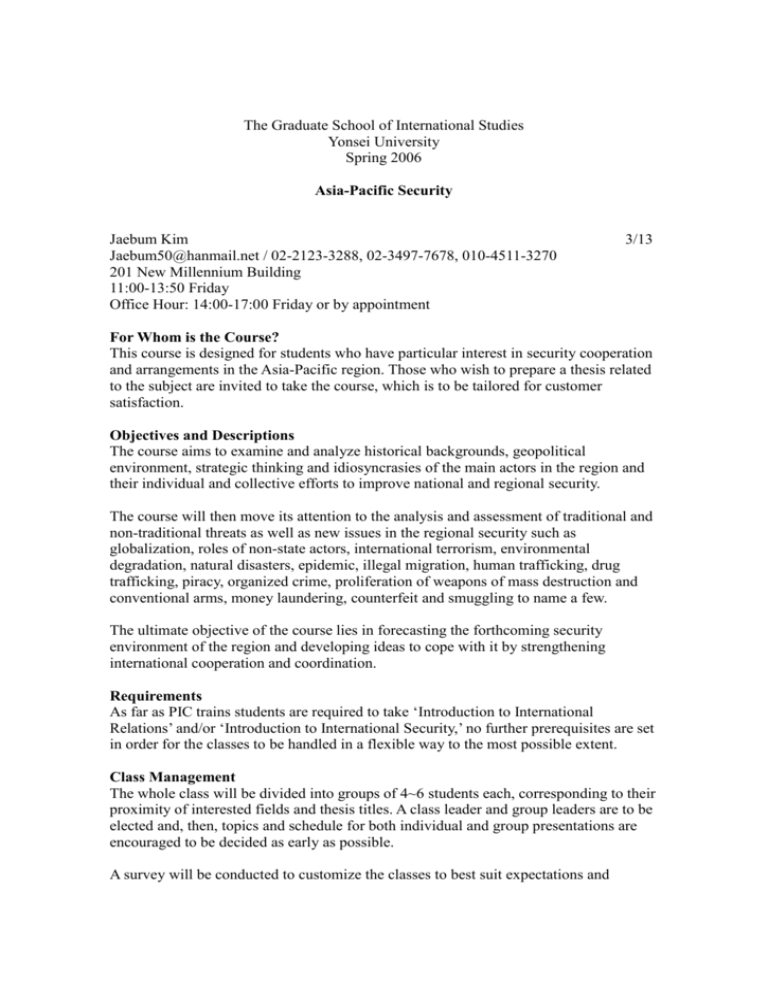
The Graduate School of International Studies Yonsei University Spring 2006 Asia-Pacific Security Jaebum Kim Jaebum50@hanmail.net / 02-2123-3288, 02-3497-7678, 010-4511-3270 201 New Millennium Building 11:00-13:50 Friday Office Hour: 14:00-17:00 Friday or by appointment 3/13 For Whom is the Course? This course is designed for students who have particular interest in security cooperation and arrangements in the Asia-Pacific region. Those who wish to prepare a thesis related to the subject are invited to take the course, which is to be tailored for customer satisfaction. Objectives and Descriptions The course aims to examine and analyze historical backgrounds, geopolitical environment, strategic thinking and idiosyncrasies of the main actors in the region and their individual and collective efforts to improve national and regional security. The course will then move its attention to the analysis and assessment of traditional and non-traditional threats as well as new issues in the regional security such as globalization, roles of non-state actors, international terrorism, environmental degradation, natural disasters, epidemic, illegal migration, human trafficking, drug trafficking, piracy, organized crime, proliferation of weapons of mass destruction and conventional arms, money laundering, counterfeit and smuggling to name a few. The ultimate objective of the course lies in forecasting the forthcoming security environment of the region and developing ideas to cope with it by strengthening international cooperation and coordination. Requirements As far as PIC trains students are required to take ‘Introduction to International Relations’ and/or ‘Introduction to International Security,’ no further prerequisites are set in order for the classes to be handled in a flexible way to the most possible extent. Class Management The whole class will be divided into groups of 4~6 students each, corresponding to their proximity of interested fields and thesis titles. A class leader and group leaders are to be elected and, then, topics and schedule for both individual and group presentations are encouraged to be decided as early as possible. A survey will be conducted to customize the classes to best suit expectations and suggestions of the majority of students. Outside lecturers can be invited as desired by students, and outdoor classes will be available as weather permits. The whole class will move from the classroom to a dining room each week at 12:30 to share lunch, which is to be paid by the professor, unless brownbag seminars are possible within the classroom. Assessment The students will not be evaluated on the basis of their knowledge, talents or intelligence but entirely of sincerity to be displayed throughout the semester. The criteria can be summarized into ‘7 Ps’: preparation, presence, punctuality, participation, presentation, process and progress, and described as the following: Class preparation and attendance; 30% Participation and contribution; 20% Group research paper and presentation; 30% Individual research paper and presentation; 20% No examinations are planned unless the majority of students want otherwise. However, preliminary grading will be informed individually in Week 13 and those who are not satisfied with it may challenge to apply for examinations with simple-answer questions. Readings Selected publications by the Ministry of Foreign Affairs and Trade, Institute of Foreign Affairs and National Security, Asia-Pacific Center for Security Studies(APCSS), Center for Strategic and International Studies(CSIS) Pacific Forum Selected writings in the latest issues of such journals as Arms Control Today, Asian Affairs, Asian Survey, The Atlantic, Australian Journal of International Affairs, Bulletin of Atomic Scientists, Central Asian Survey, China: an international journal, Contemporary Southeast Asia, Current History, East Asian Review, The Fletcher Forum of World Affairs, Foreign Affairs, Foreign Affairs Journal, Foreign Policy, International Affairs, International Negotiation, International Security, The National Interest, The Nonproliferation Review, Review of International Studies, Security Dialogue, The Washington Quarterly, World Policy Journal, etc. News analyses, columns and contributions in such periodicals as Christian Science Monitor, International Herald Tribune, Los Angeles Times, New York Times, The Times, Washington Post, The Economist, Far Eastern Economic Review, Jane’s Defence Weekly, Newsweek, Time, U.S. News and World Report, Vital Speeches, etc. Youngmin Kwon. Regional Community-Building in East Asia. Seaul: Yonsei University Press, 2002. David Capie and Paul Evans. Asia-Pacific Security Lexicon. Singapore: Institute of Southeast Asian Studies, 2002. 2 Richard W. Baker and Charles E. Morrison (eds.). Asia Pacific Security Outlook. Tokyo: Japan Center for International Exchange, 2004, 2005 & 2006. The International Institute for Strategic Studies. Strategic Survey 2004/5. Oxford: Routledge Journals, 2005, pp.283~384. Marika Vicziany, David Wright-Neville and Pete Lentini (eds.). Regional Security in the Asia Pacific: 9/11 and After. Cheltenham: Edward Elgar, 2004. Annelies Heijmans, Nicola Simmonds and Hans van de Veen (eds.). Searching for Peace in Asia Pacific: An overview of Conflict Prevention and Peacebuilding Activities. London: Lynne Rienner Publishers, 2004. See Seng Tan and Amitav Acharya (eds.). Asia-Pacific Security Cooperation: national interests and regional order, Armonk, NY: ME Sharpe, 2005. Course Schedule Week 1 (Mar. 3): Introduction Self-introduction Orientation Survey Week 2 (Mar. 10): Thinking about Security How do you define security? How much security is enough? Is security negotiable? Security Community Security Cooperation Security Dilemma Security Pluralism New Security Approach Collective Security Common Security Comprehensive Security Co(-)operative Security Mutual Security National Security Homeland Security International Security Regional Security Global Security Human Security 3 Track One Track One-and-a-Half Track Two Track Three Harald Muller. ‘Security Cooperation’ in Walter Carlsnaes, Thomas Risse and Beth A. Simmons, Handbook of International Relations, London: SAGE Publications, 2002, pp.369~391. Asia-Pacific Security Lexicon, pp. 53~75, 98~107, 139~146, 171~178, 198~219. Asia Pacific Security Outlook 2005, pp.23~33. Week 3 (Mar. 17): Thinking about the Asia-Pacific Region How do you define the Asia-Pacific? What are the characteristics of the region? What lies ahead in terms of security? Open Regionalism APEC, ASEM PBEC, PECC CSCAP Asia-Pacific Security Lexicon, pp.179~184. Regional Community-Building in East Asia, pp.97~184. Asia Pacific Security Outlook 2005, pp. 9~19. Strategic Survey 2004/5, pp.283~284. Week 4 (Mar. 24): Structure and Actors of the Regional System Does a system exist in the Asia-Pacific? Does a structure matter? Anarchy vs. hierarchy Middle Power Balance of Power Cold War Mentality International Organizations Nation States Sub-state actors Non-state actors: NGOs, MNCs, etc. Asia-Pacific Security Lexicon, pp.28~38, 45~47, 161~164. 4 Desmond Ball. ‘Security Cooperation in Asia Pacific: Official and Unofficial Responses’ in Searching for Peace in Asia Pacific: An overview of Conflict Prevention and Peacebuilding Activities, pp.37~52. (Choose 2~3 articles of your particular interest.) David Reese. ‘North Korea: anatomy of a rogue state’ in Regional Security in the Asia Pacific: 9/11 and After, pp.248~263. Bruce E. Bechtol, Jr. ‘U.S.-North Korean Relations and the Bush Administration: The Political-Diplomatic Dimension of the Nuclear Confrontation’ in East Asian Review, (17:4) Winter 2005, pp.123~. C. Kenneth Quinones. “Kim Jong Il’s ‘Strong and Great Nation’ Campaign and the DPRK’s Deterrence of the U.S. ‘Imperialist’ Threat’ in Bytes and Bullets: Information Technology Revolution and National Security on the Korean Peninsula, Honolulu: AsiaPacific Center for Security Studies, 2005, pp.276~298. The International Crisis Group. China and North Korea: Comrades Forever?, Nautilus Institute, Feb. 1, 2006. Andrew Scobell and Michael R. Chambers. ‘The Fallout of a Nuclear North Korea’ in Current History, (104:683) Sep. 2005, pp.243~250. Ian Brmmer, Choi Sung-hong & . ‘A New Forum for Peace’ in The National Interest, (No.82) Winter 2005/6, pp.107~111. Tim Beal. ‘Multilayered Confrontation in East Asia: North Korea-Japan’ in Asian Affairs, (XXXVI:III) Nov. 2005, pp.339~360) ‘Continuing Crisis on the Korean Peninsula’ in Strategic Survey 2004/5, pp.285~295. Scott Snyder. ‘South Korea’s Squeeze Play’ in The Washington Quarterly, (28:4) Autumn 2005, pp.93~106. Doug Bandow. ‘Seoul Searching’ in The National Interest, (No. 81) Fall 2005, pp.111~116. Week 5 (Mar. 31): Major Powers in the Asia-Pacific USA China Russia Japan India The rise of ‘Chindia’? 5 (Choose 2~3 articles of your particular interest.) Maurice R. Greenberg. ‘On Leadership’ in The National Interest, (No.82) Winter 2005/6, pp.25~29. Robert S. Ross. ‘Assessing the China Threat’ in The National Interest, (No. 81) Fall 2005, pp.81~87. Chen Xiangyang. ‘Assessments of International Situation and China’s Security Environment in 2005’ in Foreign Affairs Journal, No.78, Dec. 2005, pp.17~25. James H. Nolt. ‘Pentagon Plays Its China Card’ in World Policy Journal, (XXII:3) Fall 2005, pp.25~33. Aaron L. Friedberg. ‘The Future of U.S.-China Relations: Is Conflict Inevitable?’ in International Security, (30:2) Fall 2005, pp.7~45. Rex Li. ‘China and Regional Security—External Perceptions and Responses,’ Suisheng Zhao. ‘China’s Perception of External Threats to Its Security and Stability’ and Chyungly Lee. ‘Taiwan: Building Cooperation Across the Taiwan Strait’ in Searching for Peace in Asia Pacific: An overview of Conflict Prevention and Peacebuilding Activities, pp.181~238. William T. Tow. “Sino-American relations and the ‘Australian factor’: inflated expectations or discriminate engagement?,” Hugh White. ‘The limits to optimism: Australia and the rise of China’ and Stuart Harris. ‘China’s regional policies: how much hegemony?’ in Australian Journal of International Affairs (59:4) Dec. 2005, pp.451~492. ‘China: Growing Power, Troubled Diplomacy’ in Strategic Survey 2004/5, pp.296~314. William A. Callahan. ‘How to Understand China: dangers and opportunities of being a rising power,’ and Arthur Waldron. ‘The rise of China: military and political implications’ in Review of International Studies, (31:4) Oct. 2005, pp.701~733. Jeniffer Lind. ‘Dangerous Games: The most heated competition in the 2008 Olympics could take place not in a stadium but in the Taiwan Strait’ in The Atlantic, (297:2) Mar. 2006, pp.38~41. James Clay Moltz. ‘U.S.-Russian Relations and the North Korean Crisis: A Role for the Russian Far East?’ in Asian Survey, Sep./Oct. 2005, pp.722~735. John Boyd. ‘China and Japan’ in Asian Affairs, (XXXVI:III) Nov. 2005, pp.275~288. Kent E. Calder. ‘China and Japan’s Simmering Rivalry’ in Foreign Affairs, (85:2) Mar./Apr. 2006, pp.129~139. ‘Japan’s Diplomatic, Economic and Political Vitality’ in Strategic Survey 2004/5, 6 pp.360~374. David C. Kang. ‘Japan: U.S. Partner of Focused on Abductees?’ in The Washington Quarterly (28:4) Autumn 2005, pp.107~117. Peng Er Lam. ‘Japan’s Deteriorating Ties with China: The Koizumi Factor’ and Sow Keat Tok. ‘Neither Friends of Foes: China’s Dilemmas in Managing its Japan Policy’ in China: an international journal, (3:2) Sep. 2005, pp.275~3000. Stephen P. Cohen. ‘India Rising,’ The Wilson Quarterly, Summer 2000. Robert Einhorn. ‘Limiting the Damage: The U.S.-Indian Nuclear Deal’ in The National Interest, (No.82) Winter 2005/06, pp.112~116. Zia Mian and M.V. Ramana. ‘Wrong Ends, Means, and Needs: Behind the U.S. Nuclear Deal with India’ in Arms Control Today, (36:1) Jan./Feb.2006, pp. ‘India and America: Joining the nuclear family’ in The Economist Mar. 4, 2006, pp.27~28. Hugo Restall. ‘India’s Coming Eclipse of China’ in Far Eastern Economic Review, (169:2) Mar. 2006, pp.12~17. ‘India Outsmarts China’ in Foreign Policy, Jan./Feb. 2006, pp.30~31. Wolfgang Schurer. ‘A Geopolitical and Geo-economic Overview: On the Rise of China and India as Two Asian Giants’ in The Fletcher Forum of World Affairs, (29:2) Summer 2005, pp.145~. Week 6 (Apr. 7): Sub-regional Security Issues ASEAN, ASEAN+3, ASEAN PMC, ARF The ‘ASEAN Way’ SAARC SCO, Boao Club AOSIS NEACD East Asian Summit Dominik Heller. ‘The Relevance of the ASEAN Regional Forum (ARF) for Regional Security in the Asia-Pacific’ in Contemporary Southeast Asia, (27:1) Apr. 2005, pp.123~145. (Choose 2~3 more articles of your particular interest.) Asia-Pacific Security Lexicon, pp.14~27. Regional Community-Building in East Asia, pp.13~96, 185~226. 7 Jurgen Ruland. ‘The Nature of Southeast Asian Security Challenges’ in Security Dialogue, (36:4) Dec. 2005, pp.545~563. Damon Bristow. ‘The Five Power Defence Arrangements: Southeast Asia’s Unknown Regional Security Organization’ in Contemporary Southeast Asia, (27:1) 2005, pp.1~20. ‘Fragile Stability and Resolve in Southeast Asia’ in Strategic Survey 2004/5, pp.345~359. ‘India and Pakistan: Cautious Engagement’ in Strategic Survey 2004/5, pp.315~332. S. Paul Kapur. ‘India and Pakistan’s Unstable Peace: Why Nuclear South Asia Is Not Like Cold War Europe’ in International Security, (30:2) Fall 2005, pp.127~152. Pete Lentini. ‘The Shanghai Cooperation Organization and Central Asia’ in Regional Security in the Asia Pacific: 9/11 and After, pp.128~147. Russell Ong. ‘China’s Security Interest in Central Asia’ in Central Asian Survey, (24:4) Dec. 2005, pp.425~439. Subodh Atal. ‘The New Great Game’ in The National Interest, (No. 81) Fall 2005, pp.101~105. ‘Afghanistan and the New Central Asian Security Complex’ in Strategic Survey 2004/5, pp.333~344. Haidi Soesastro. ‘East Asia: Many Clubs: Little Progress’ in Far Eastern Economic Review, (169:1) Jan./Feb. 2006, pp.50~54. ‘Continuing Crisis on the Korean Peninsula’ in Strategic Survey 2004/5, pp.285~295. Week 7 (Apr. 14): Culture, Religion and Security What is soft power? Anti-Americanism Historical baggage ‘Korean Wave’ phenomenon Gary Anderson. ‘Vietnam and World War Two’ in Vital Speeches, (LXXII:6) Jan. 1, 2006, pp.181~186. Lucian W. Pye. ‘Asian Values: From a Generator to a Domino?’ in Samuel P. Huntington and Lawrence E. Harrison (eds.), Culture Matters, New York: Basic Books, 2000, pp. Samuel P. Huntington. The Clash of Civilization and the Remaking of World Order. New York: Simon & Schuster,1997, pp. 8 Week 8 (Apr. 21): Nationalism and Ethnic Separatism Nationalism, ethnicity, patriotism, racism, chauvinism, xenophobia, etc. Fundamentalism, fanaticism, extremism, radicalism, isolationism, etc. Gemeinschafts based on clan, tribe, nationality, race, religion, language, caste, region, etc. Potential of multilateral initiatives for peaceful resolution of separatist conflicts Pascal Boniface. ‘Proliferation of States’ in The Washington Quarterly, Summer 1998, pp.111~127. Ted Robert Gurr. ‘Ethnic Warfare on the Wane’ in Foreign Affairs, May/June 2000, pp.52~64. Eric Heginbotham and Christopher P. Twomey. ‘America’s Bismarckian Asia Policy,’ and Peter Hays Gries. ‘Chinese Nationalism: Challenging the State?’ in Current History, (104:683) Sep. 2005, pp.243~256. Week 9 (Apr. 28): Economic Aspects of Security Sub-regional, regional and inter-regional integration: NEAEC, APEC, ASEM, FEALAC, etc. Trade issues: WTO, DDA, FTAs, etc. Population, resource depletion, environmental degradation, natural disasters Infectious diseases: AI, SARS, AIDS/HIV, etc. Intergovernmental and intergenerational justice, digital divide Regional Community-Building in East Asia, pp.227~282. United States Pacific Command. Asia-Pacific Economic Update 2005, Chapter 1, Asia’s Growing Global Economic Role. Yumei Zhang. ‘The rise of regionalism in Pacific Asia: Contested visions, changing realities’ in Pacific Asia: The politics of development, London and New York: Routledge, 2003, pp.136~. Barry C. Lynn. ‘War, Trade and Utopia’ in The National Interest, (No.82) Winter 2005/6, pp.31~38. Brian R. Shaw. ‘When are Environmental Issues Security Issues?,’ Features, pp.39~44. Elizabeth Economy. ‘China’s Environmental Challenge’ in Current History, (104:683) Sep. 2005, pp.278~283. Peter Hayes, David von Hippel, Jungmin Kang, Matsujiro Suzuki, Richard Tnter & Scott Bruce. ‘Talks dead-locked’ in Bulletin of Atomic Scientists, (62:1) Jan./Feb. 2006, pp. 9 Scott Snyder. “‘Digital Divide’ between North and South Korea: Obstacles and Incentives for IT Sector Cooperation” in Bytes and Bullets: Information Technology Revolution and National Security on the Korean Peninsula, Honolulu: Asia-Pacific Center for Security Studies, 2005, pp.345~367. Week 10 (May 12): Human Rights and Humanitarian Issues Historical developments and current trends in the region Universal rights vs. domestic issues Issues of ‘double standards’ Political rights in the PRC and DPRK Refuges issues Humanitarian Intervention Asia-Pacific Security Lexicon, pp.161~164. Thomas M. Franck. ‘Are Human Rights Universal?,’ Foreign Affairs, Jan./Feb. 2001, pp.191~204. K. Christie & D. Roy. The Politics of Human Rights in East Asia, London: Pluto Press, 2001, pp.1~28. Kapil Kak. ‘Humanitarian Intervention and the Changing Role of UN,’ Strategic Analysis, Oct, 2000. Final Declaration of the Regional Meeting for Asia of the World Conference on Human Rights, Bangkok, April 2, 1993. Asia Pacific Security Outlook 2005, pp.23~33. Week 11 (May 19): Transnational Violence and International Terrorism Organized crime Biochemical terrorism Cyber terrorism Maritime piracy Violation of intellectual property Human trafficking and illegal migration Counterfeit Money laundering Contraband Drug trafficking Rogue states Failed states Terrorism-sponsoring states Non-state groups Rohan Gunartna. ‘Transnational Threats in the Post-Cold War Era,’ Jane’s Intelligence 10 Review, Jan. 1, 2001. Paul J. Smith. ‘Transnational Security Threats and State Survival: a Role for the Military?,’ Parameters, Autumn 2000, pp.77~91. Audrey Kurth Cronin. Behind the Curve; Globalization and International Terrorism, International Security, Winter 2003. Moises Naim. The Five Wars of Globalization, Foreign Policy, Jan. 2003, p. 28. Week 12 (May 26): Proliferation of Weapons of Mass Destruction and Conventional Arms Nuclear arsenal in the region Emphasis on maritime and air power Broader application of sophisticated technologies Conventional arms vs. WMDs Proliferation Security Initiative(PSI) Andrew Newman and Brad Williams. ‘The Proliferation Security Initiative: The AsiaPacific Context’ in Nonproliferation Review, (12:2) July 2005, pp.303~322. Walter C. Clemens, Jr. Negotiating to Control Weapons of Mass Destruction in North Korea’ in International Negotiation, (10:3) 2005, pp.453~486. Andrew J. Coe. ‘North Korea’s New Cash Crop’ in The Washington Quarterly, (28:3) Summer 2005, pp.73~84. Donald L. Berlin. ‘Conventional Weapons Proliferation in the Asia-Pacific Region,’ APCSS Special Report, May 2002. Week 13 (June 2): Transformation and Space Issues Force modernization Implications to the region of the U.S. Defense Transformation and QDRs(Quadrennial Defense Reports) RMA(Revolution in Military Affairs) MD(Missile Defense) Values of space and space-based assets to the regional security Roles of intelligence and C4ISR Strategic flexibility of U.S. forces in Korea? ‘Conceptual Planning 2059’ Joshua Kucera, Ramon Lopez & Andrew Koch. ‘Major US Programmes are to remain intact’ in Jane’s Defence Weekly, Feb.15, 2006, pp.8~10. Michael Krepon with Michael Katz-Hyman. ‘Space Weapons and Proliferation’ in Nonproliferation Review, (12:2) July 2005, pp.323~341. 11 Geoffrey T. Richardson. ‘The whole world is watching’ in Bulletin of Atomic Scientists, (62:1) Jan./Feb. 2006, pp. Gary D. Rawnsley. “Old wine in new bottles: China-Taiwan computer-based ‘information warfare’ and propaganda” in International Affairs, (81:5) Oct. 2005, pp.1061~1078. Paul Dibb. ‘The Revolution in Military Affairs and Asian Security,’ Survival, Winter 1997/98, pp. Otis Port with Inka Resch. ‘They’re Listening to Your Calls’ in Business Week, May 31, 1999, pp.110~111. Bruce Sterling. ‘Peace is War,’ Wired, April 2002, pp.79~89. Sung-pyo Hong. ‘Impact of Information Technology Revolution on Revolution in Military Affairs in the ROK Armed Forces in Bytes and Bullets: Information Technology Revolution and National Security on the Korean Peninsula, Honolulu: Asia-Pacific Center for Security Studies, 2005, pp.218~233. Young-Kil Kim. ‘Status of Korean Navy’s Tactical C4ISR Systems Acquisition and Issues on Interoperability between ROK-US Combined Naval Operations’ in Bytes and Bullets: Information Technology Revolution and National Security on the Korean Peninsula, Honolulu: Asia-Pacific Center for Security Studies, 2005, pp.179~200. Week 14 (June 9): Multilateralism in the Asia-Pacific Unilateralism, bilateralism vs. multilateralism To what extent can multilateral activities enhance security? How can we institutionalize the Asia-Pacific? Can multilateralism survive without the U.S. in the region and worldwide? Unilateralism Bilateralism Multilateralism Ad Hoc Multilateralism Concerted Unilateralism Asia-Pacific Security Lexicon, pp.11~13, 82~83, 165~170. Kuik Cheng-Chwee. ‘Multilateralism in China’s ASEAN Policy: Its Evolution, Characteristics, and Aspiration’ in Contemporary Southeast Asia, (27:1) April 2005, pp.102~122. Akiko Fukushima. ‘Japan’s Emerging View of Security Multilateralism in Asia’ in Ralph Cossa et al, Security Multilateralism in Asia: Views from the United States and Japan, Institute of Global Conflict and Cooperation, Policy Paper 51, June 1999. 12 John S. Park. ‘Inside Multilateralism: The Six-Party Talks’ in The Washington Quarterly (28:4) Autumn 2005, pp.75~91. Week 15 (June 16): Looking Ahead What will be the future of the region? What can be done for a more secure region? Is the European model workable in the Asia-Pacific? How soon? How far will globalization go? Coercive Diplomacy Collective Defense Concert of Powers Constructive Intervention Humanitarian Intervention Engagement ‘Congagement’ Flexible Consensus Preventive Diplomacy Transparency Confidence-Building Measures Confidence- and Security-Building Measures Trust Building Measures Cooperative Threat Reduction(CTR) Asia-Pacific Security Lexicon, pp. 43~44, 48~52, 76~81, 84~97, 108~138, 147~160, 185~197, 220~224. Eric Newsom. ‘Uniting the Tools of Force and Diplomacy to Enhance Security,’ 2005. Thomas L. Friedman, ‘Opening Scene: the World is Ten Years Old,’ Chapter 1, The Lexus and the Olive Tree, New York: Anchor Books, 2000, pp. xi~xxii. National Intelligence Council. Mapping the Global Future, Report of the National Intelligence Council’s 2020 Project, December 2004. Asia Pacific Security Outlook 2006. Strategic Survey 2005/6, pp.375~. 13
